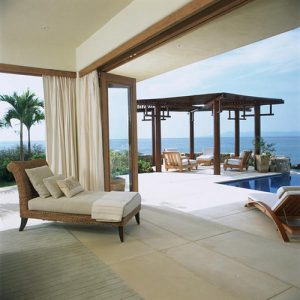Like a Myth Busters on the Discovery Channel I have always been curious if it is possible to “bust the myth” of whether you can keep a house cool using only a smart design and without using air conditioning. Is it really possible? Can we really keep a house in Southern Spain cool in a summertime?

As Cameron Tonkinwise has noted “the window air conditioner allows architects to be lazy. We don’t have to think about making a building work, because you can just buy a box.” The property boom in Spain encouraged sloppy design. Nobody bothered to build an efficient building or to design natural ventilation, or think about window placement, etc. They would just switch on AC. Using the AC we literally pass the heat from inside to outside and this way increasing the temperature outside and burning fossil fuels in the process.
A report in the March 2005 issue of ‘Energy in Buildings and Industry’ magazine stated that air conditioning typically adds 50% to the energy consumption of a building. Clearly the air conditioning is a “wrong option” in creating a sustainable living (to read more on that look at the blog on “The Evils of Air Conditioning“).
The real key to environmentally friendly cooling is in the design.
A home, like any other object, is subject to the laws of nature. If you heat it or allow the heat to enter it, whether it’s the sun, heat from cooking, or simply an inefficient light bulb, etc. it will get hot inside the house if you do nothing to balance that, eventually it becomes impossible to live there.
So the first question is how do we stop the heat entering our house? Rather than wasting money on AC, we should think and use what Mother Nature has already for us. So generally I would mention the following cooling techniques:
• Thoughtful orientation, shading, and windows placement – correct use screens, blinds, shutters, for stylish looks, security and energy efficiency. Also awnings, overhangs, and terraces to provide shade. The sun should never hit a large window directly.
• Using thermal mass – rock, stone or brick, they will collect the night coolness and give it away longer during the day. A foundation can sometimes provide you with thermal mass. Also it is advisable to keep the exposed thermal mass elements shaded.
• Insulate the building well – windows, walls. There should be almost no heat transfer through the outer shell including the windows. Highly performance windows are increasingly available and are no longer the thermal weak point in a structure.
• Using already existing thermal mass from the ground/soil – build a big thermal mass on the ground so that it would keep coolness from the ground during summer.
• Greening our living our house and environment – just imagine, a desert and a forest. Even having the same weather conditions in these two environments obviously forest is a much more attractive and “user friendly” option. So plant trees, grass, flowers, bushes, etc. Inside and around your home. With care they can go almost anywhere: walls, roofs, inside the house, outside in the garden. They both create pleasant feeling as well as cool the area efficiently. But don’t plant the shade in the southern part if you want to take advantage of the sun heat during winter.
• Energy efficient appliances – first of all, change all old light bulbs, fridges, cookers, and other appliances to new, energy efficient ones. They use less energy, they produce less heat and they don’t cost more than old ones. Secondly, use them intelligently – switch off when not using, insulate, ventilate or keep further from common rooms the parts which create heat (ex. keep the freezer in the garage, insulate the hot water container and pipes).
• A sustainable behaviour of the inhabitants – Avoid doing activities and duties which create additional heat during the hot period of a day, like washing dishes, cooking with oven. Switch off appliances when you don’t use them. Keep the windows and doors opened as little as possible during the day and widely opened during the night. Use ceiling and window fans or, as an alternative, install a ground or air source heat pump.
This is just a general overview of some techniques that provide an alternative to the air conditioning. Of course in each case they may differ. An architect should look at the whole design and provide a holistic solution. It maybe you do need some air conditioning for example in a flat in the central city. In that case use the most efficient ones, which eventually are cheaper to run compared to inefficient ones, and make sure you insulate well the whole system. Or better get the assistance from an energy auditor or AC contractor.
If you want more detailed information on the topic of this blog, I suggest reading the following articles
First Article
Second Article
Author: Eugenijus Sapel
Bio: Eugenijus is an engineering graduate of construction engineering from both Coventry Univeristy in the UK and Lithuanian VGTU and as such he has a strong theoretical knowledge in structural design and management. He is keen to develop his interest in sustainable architecture. He is currently on a 3 month internship with Eco Vida.
